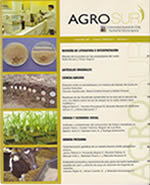Use of remote sensing and GIS in the selection of soil sampling sites for the Magallanes Region
Main Article Content
Abstract
The agricultural farms in Magallanes Region comprise vast areas, which makes complex the quantification of vegetal communities in all paddocks, and the planning of soil sampling based on these communities, due to the time and cost involved. This study proposes a method to determine homogenous zones for soil sampling, according to Geographic Information Systems and remote sensing techniques, based on open source data and software. The specific aim is determining the number of sub-samples to generate a soil composite sample. The results obtained showed a classification of vegetation with an 85.6% of global reliability from Landsat 8 data and identified the plane lands (50.3% of farm total area) using Models of Digital Elevation of ASTER GDEM. The overall information allowed to generate 237.9 hectares defined like homogenous areas for different vegetal communities. Once the homogenous areas are determined, the sampling should be selected according to the community that will be assessed, and to the site that is intended to be studied or intervened. Subsequently, the estimation of the number of soil sub-samples is determined according to the area to sample and its homogeneity features. This procedure would help reduce mistakes in soil sampling.

